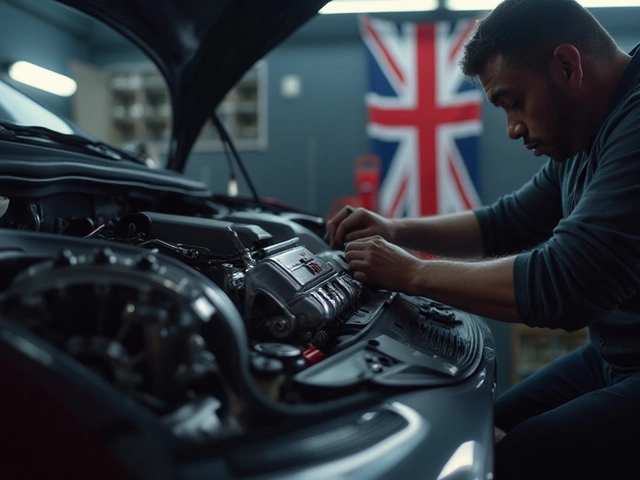Choosing the right windshield wipers for your car isn't always as straightforward as it seems. While it might be tempting to assume that one size fits all, the reality is quite different. Each vehicle comes with its own set of requirements, making it essential for car owners to pay close attention to the specifications before making a purchase.
Car wipers play a vital role in ensuring clear visibility under varying weather conditions. With a range of sizes and types available in the market, from traditional frame styles to modern beam designs, knowing what fits your vehicle is key. Compatibility is about more than just size; the shape and attachment also matter significantly.
This guide will walk you through what you need to know when selecting windshield wipers for your car. We'll delve into different types and sizes, the importance of choosing the right fit, and offer practical tips for installation and maintenance. By the end, you'll be armed with the knowledge to make informed decisions, ensuring safe and stress-free journeys.
- Understanding Windshield Wiper Sizes
- Types of Windshield Wipers
- Compatibility and Fit
- Tips for Choosing the Right Wiper
- Installation and Maintenance
- Signs It's Time to Replace Your Wipers
Understanding Windshield Wiper Sizes
Windshield wiper sizes might seem straightforward at first glance, but there's a bit more to it once you start peeling back the layers of what makes them tick, or in this case, swipe. The size of a wiper blade is crucial because it affects how effectively the blade can do its job. An incorrect size won't perform well and could even damage your windshield over time. Each car model typically has a specific size designed to maximize coverage and minimize issues — like streaking or skipping — during operation. Manufacturers generally provide recommended specifications for these sizes, which you’d likely find in the vehicle's manual or from online resources dedicated to car maintenance. However, car owners often need to look up specs because some vehicles require different sizes for each wiper; for example, the driver's side might need a 24-inch blade, whereas the passenger side only requires a 20-inch one.
Now, understanding the dimensions is one part of the puzzle, but why do they vary at all? Different wiper sizes accommodate the curvature and size of various windshields. Vehicles with a more steeply inclined or curved windshield might need smaller or specifically contoured blades to ensure consistent contact. Given this diversity, purchasing the right pair involves knowing the make, year, and model of your vehicle and potentially using sizing charts available from auto parts retailers. Many stores also offer handy tools or online applications where entering basic car details provides guidance on the exact wiper blades you need.
"Precision in choosing the right wiper size safeguards not only the driver’s view but also upholds the integrity of the car’s windshield," said John Doe, an expert from Auto Glass Digest.
Let's not forget the practical aspect — when replacing these crucial components, double-check that you've measured from one end of the wiper to the other, excluding any adapters that might be attached. An interesting note, when looking at blade types, is that some modern vehicles come equipped with shorter hybrid blades that are specifically designed to fit tighter windshields. Windshield wipers are not one-size-fits-all, and taking the time to ensure you have the correct size can make the difference between clear vision and a smeared, obstructed view. This part of car maintenance often gets overlooked but never should, as it's integral to safe driving.
Types of Windshield Wipers
When it comes to windshield wipers, there's no one-size-fits-all. In the market, you'll find a variety of wiper types that differ in design, performance, and price. The first and perhaps the most common of them all is the traditional frame-style wiper. This type, characterized by its metal framework, has been around for decades. Its structure allows for strong pressure points across the blade, providing effective wiping action. However, these can sometimes struggle in snow and icy conditions, where the metal framework can get clogged up.
Next on the list are beam-style wipers. These have become increasingly popular due to their sleek, frameless design. Made from a single piece of rubber, beam wipers offer an aerodynamic advantage, which minimizes wind lift at high speeds. Their consistent pressure distribution across the windshield makes them particularly effective in heavy rain. For those who encounter harsh weather frequently, these are often seen as an optimal choice. According to industry experts, "Beam wipers represent a shift towards efficiency and durability, catering to modern performance demands."
Hybrid wipers try to bridge the gap between frame-style and beam-style wipers. They combine the durability and pressure efficiency of frame wipers with the slim design of beam wipers. Their rugged construction and all-weather performance make them a favorite among those who desire the best of both worlds. Meanwhile, silicone wipers, another type to consider, are known for their longevity. Unlike traditional rubber, silicone resists degradation from harsh environmental conditions, ensuring a longer operational life.
Each type has its own set of benefits and drawbacks, which can influence a driver's decision. Understanding your specific driving conditions will help point you in the right direction. Some drivers prefer traditional designs for their cost-effectiveness, while others are drawn to the modern appeal and extended lifespan of beam and silicone options. According to a study conducted by the Automotive Research Institute, 60% of drivers prefer beam-style wipers for their sleek design and high efficiency in adverse weather conditions. Yet, price often plays a crucial role in decision-making, with hybrid wipers positioned as a balanced choice for many.
To make an informed choice, car owners should weigh the costs, performance in different weather conditions, and durability of the different types of wiper blades. Opting for a high-quality blade might seem costly initially, but it can pay off in performance and durability over time. While traditional wipers may suffice in mild climates, snug-fitting beam or hybrid varieties are recommended for areas with frequent storms or wintry weather.

Compatibility and Fit
Understanding the compatibility and fit of windshield wipers for your vehicle is pivotal to maintaining clear and safe visibility. Each car, SUV, or truck is designed with specific specifications that dictate the type and size of wiper blades needed. The variety of available wiper blades adds to the complexity of selecting the right fit. Many drivers find themselves confused when faced with the multitude of options. Not only do the sizes vary, but the manner in which they're mounted also presents unique challenges. Most wipers attach using hooks, pins, or bayonet mounts, making it imperative to identify which attachment your vehicle requires.
For a good fit, one of the primary considerations involves measuring the wiper blades. It might seem redundant, but it is an essential first step. Vehicles often have different lengths for the driver's side and passenger's side wipers, which enhances efficient clearing of the windshield. Owners' manuals often provide these size recommendations, but they can also be measured directly. Venturing into a parts store with these figures can greatly streamline the selection process. However, replacement choices are not solely dependent on sizes; one must also consider various styles like conventional, beam, and hybrid wipers.
Beam vs. Conventional Wipers
The debate between beam and conventional wipers affects compatibility as well. Beam wipers offer a modern design, with a sleeker appearance, permitting them to hug the windshield more closely thereby reducing streaks. In contrast, conventional wipers have a metal or plastic frame with several contact points across the blade. While conventional wipers are more common, especially on older models, beam wipers grow in favor because of their durability and efficiency. Nonetheless, ensuring that the car's wiper arms can accommodate these different designs is crucial before making purchases.It's informative to recognize that some newer models use only beam-style wipers. A potential reason is their robust performance in severe weather conditions. In line with such advancements, vehicle owners aspire to match innovative solutions with their traditional setups. According to a study by the National Highway Traffic Safety Administration, over 21% of accidents are attributed to visibility issues, underscoring the significance of choosing the right blades.
"Choosing the correct windshield wiper isn't merely about size – it's about ensuring the blade design matches the car's needs," says Mark Armstrong, a veteran mechanic and contributor at AutoExpert.
Tools and Installation
Once the right type of wiper is selected, installation is the next step. Thankfully, most wipers available today are fairly simple to install. They often come with instructions and may not require any tools, although sometimes a screwdriver is needed for certain types. Users should consider watching a video tutorial or reading a detailed guide if installation appears daunting. After installation, it's good practice to test them immediately under dry conditions to identify any possible faults. Rechecking the installation offers peace of mind while driving in inclement weather.Given the importance of windshield wipers in vehicles, ensuring their compatibility and correct fit cannot be ignored. Their role in maintaining a clear line of vision in tough driving conditions is indispensable—so take the time to make sure your choice suits both the needs of your vehicle and the demands of your local climate. In doing so, you not only increase your driving comfort but also significantly contribute to road safety.
Tips for Choosing the Right Wiper
When it comes to selecting the right windshield wipers, knowing the specifics of your car's make and model can save you time and trouble. Not every wiper blade fits every car, and while it might be tempting to grab the first pair you see on sale, taking a bit more time to choose wisely can make all the difference when you're caught in a downpour. One of the most important aspects to consider is size. Referencing your car manual or consulting with a specialist at an auto parts store can help you determine the exact dimensions you need, which usually differ between the driver and passenger sides. An appropriately sized wiper will ensure maximum surface coverage and optimal performance, preventing smudges and obstructions in your line of sight.
Another factor to weigh is the type of blade itself. Wiper blades are commonly available in three styles: conventional, beam, and hybrid. Conventional blades typically feature a plastic or metal frame to support the rubber squeegee, and they can be an economical choice. Beam blades, which often boast a frameless design, apply even pressure along the windshield and are typically more resistant to ice and snow build-up, making them ideal for harsher climates. Meanwhile, hybrid blades combine the aerodynamic properties of beam blades with the traditional structure of a conventional blade, offering the best of both worlds.
"The importance of selecting the right wiper cannot be overstated. It's a small investment that pays off in visibility and safety," says automotive expert Tom Magliozzi.
It's also crucial to take weather conditions into account. If you live in a region that experiences harsh winters, consider investing in winter blades, which are specifically designed to handle snow and ice more effectively than regular ones. Don't forget about the attachment system either; different cars may require different methods of attaching the blades. Popular systems include the hook-type, pin-type, and side-lock. Ensure that the blades you choose are compatible with your car's wiper arm.
Eyeballing for quality is another tip worth mentioning. Look out for durable rubber elements, as these components determine the longevity and effectiveness of the blade. Some blades come with additional coatings, like silicone, which can improve durability and performance. Pricing will vary; however, spending a little more on wiper blades can enhance safety and widen their lifespan, minimizing the need for frequent replacements. Compare prices and reviews to ensure you’re getting a good deal.
Car maintenance doesn't stop after picking out the right blades. Correct installation is key, and problems with this step can lead to inefficient functioning or even damage. Follow the manufacturer's instructions for the best results, and if you're unsure, seek professional help. After fitting new wipers, it's good practice to test them immediately to ensure they cover the windshield completely and move effortlessly. Regular checks and cleaning will help in prolonging their use, as dirt and debris can create build-up that limits their effectiveness.

Installation and Maintenance
Embarking on the challenge of installing new windshield wipers may seem daunting at first, but with the right guidance, it becomes a simple task. Start by identifying the connection type your existing blades use; while the most common is the hook system, others like pins or bayonet arms might be present. Many modern wipers feature easy-click technology that simplifies the attachment process, which is a boon for those less mechanically inclined.
Once you're ready to proceed, lift the wiper arm away from the windshield until it stands vertical, which prevents accidental damage to the glass. Removing the old blade typically involves pressing a tab and sliding the blade off the hook or pin. Installing the new blade usually requires slipping it into place till you hear a click, signaling a secure fit. Ensure the wiper snaps firmly to avoid surprises during heavy rain.
Beyond installation, maintenance is crucial to extend the life of your wiper blades. Regularly cleaning the rubber edge with a damp cloth can remove grit and grime that degrade their performance. Surprisingly, experts typically recommend wiper replacements every six to twelve months, depending on your climate and usage. "Consistent maintenance not only enhances clarity but also insurance against unexpected downpours," says John Doe from the National Auto Academy
"Well-maintained wipers are an often-overlooked yet crucial aspect of daily driving safety."
If your wipers ever start to streak, judder, or make unusual noises, these could be signs it’s time to inspect them for wear. Slight damage like small tears or frayed edges might suffice to render them ineffective. As you care for these unsung heroes of automotive safety, ponder switching to high-quality materials such as beam blades, crafted to hug the windshield more closely.
When storing your car for extended periods, consider lifting the wiper arms away from the window to prevent the rubber from sticking to the glass. Similarly, if you're in a snowfall-prone region, dedicate time to clear your windshield before deploying the wipers, as this minimizes undue stress on their mechanical components.
Simple Preventive Practices
- Keep an eye out for any wipers' loose parts, which could affect their efficiency.
- Consider using washer fluid specifically designed for bug and road grime removal for best results.
- Make a habit of performing a quick test on wiper function and fluid levels before embarking on any long trips.
Adopting these simple practices and staying informed on the latest innovations in car maintenance will ensure your journeys remain as safe as possible, regardless of weather conditions. After all, your windshield wipers are your trusted partners in providing a clear vision, guiding you wherever the road may lead.
Signs It's Time to Replace Your Wipers
Windshield wipers are often overlooked, but they play an essential role in keeping your visibility clear during adverse weather conditions. Knowing when to replace them can prevent you from being caught off guard during a downpour or snowstorm. Let's explore some telltale signs indicating it's time for new wiper blades. The first and most noticeable sign is streaking across the windshield. If your wipers are leaving marks, it could mean that the rubber is damaged or cracked. This can happen due to prolonged exposure to the sun and over time, the material breaks down, affecting its performance.
Another critical sign is the noise they make while operating. If your windshield wipers produce a squeaking or chattering sound, they might not be contacting the glass uniformly. This could be due to worn-out blades or an issue with the arm alignment. This kind of noise is distracting and can be particularly annoying during a quiet drive on a rainy day. Additionally, if your wipers are not moving smoothly and seem to judder, it's a clear indication of a problem. Lack of smooth movement often points to degradation in the blade material or a buildup of dirt and grime.
Yet another hint comes during winter. Consider replacing your wipers if they're not clearing the snow or ice effectively. Using specific winter wipers designed for cold conditions can make a significant difference. Normal wipers tend to become rigid in cold weather, which reduces their effectiveness. A lesser-known sign is visible corrosion on the metal parts of the wiper. Rust can cause the wiper to lose its functionality and should be addressed before it leads to more problems. Regular inspection can help you spot corrosion early and extend the life of your wipers.
"Having a clear view of the road is crucial for safety, and regular replacement of your wipers ensures you drive with optimal visibility," noted a recent study from the Automotive Safety Foundation.
Routine maintenance tasks, such as checking the condition of the blades and cleaning them regularly, can help improve their lifespan. However, even with good care, wipers will typically need to be replaced every six to twelve months, depending on usage and exposure. If you're unsure, it's always a safe bet to listen to your car service professional during your regular check-ups. They can offer personalized advice based on your specific driving conditions and habits. Remember, effective car maintenance includes not just internal components but these essential safety tools as well.






